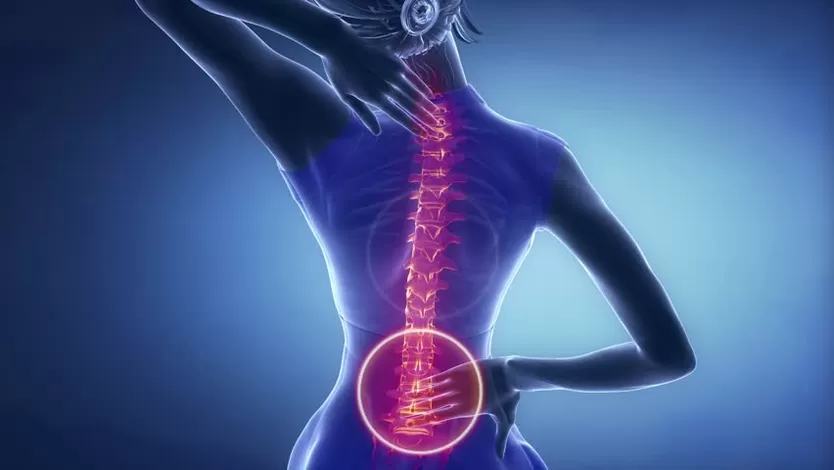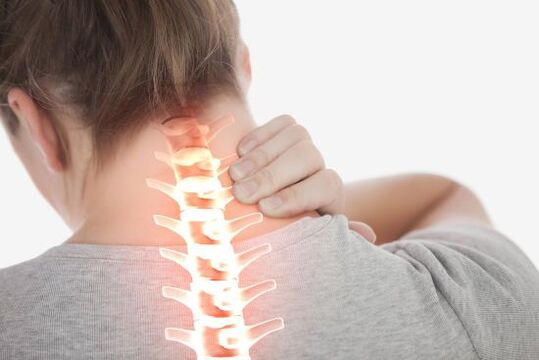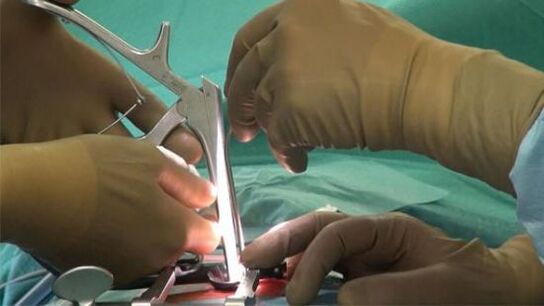
Osteochondrosis is a disease characterized by degenerative lesions of the cartilage tissues of the spine. Lack of proper therapy leads to disruption of the structure and dysfunction of the intervertebral discs, deformity of the spinal column. Depending on the location of the pathological process, there are the following types of osteochondrosis: neck, chest, lumbar. Statistics show that this disease affects more than half of the world's population over the age of 35. The main causes of its formation are injuries, systematic uneven loading of the spine and legs.
Which
Speaking of osteochondrosis, it must be said that this disease causes damage to the structure of the tissues of the intervertebral discs, reduces their elasticity and changes their shape. At the same time, the distance between them decreases, which ultimately leads to a loss of stability of the spinal column.
As a result of the contraction of the intervertebral space, nerve endings from the spinal cord are pinched. This increases muscle tone and pain.
Decreased elasticity causes the development of intervertebral hernias and protrusion (a disease in which the vertebrae begin to bulge into the spinal canal without rupturing the annulus fibrosus). And if the treatment is done incorrectly or is completely absent, it will lead to the breakdown of the joints of the spine and ligaments with further formation of osteophytes (bone processes).
The development of osteochondrosis causes a violation of motor functions. The person begins to be disturbed by the constant pain in the abnormal focus area, which increases during bending / extension of the back. There is a high probability of subluxation, back curvature.
Usually, the first symptoms of the disease in humans occur during the period of physiological aging of the body. But there are situations where the pathology begins to develop much earlier. And this is often due to the wrong lifestyle.
It also exists in medicine like chondrosis and has similar symptoms and etiology. What is the difference between chondrosis and osteochondrosis? It's simple. Chondrosis is the initial stage in the development of osteochondrosis, when the processes of replacing damaged tissue with fibrosis and the formation of osteophytes have not yet begun in the spinal column. When there is a pronounced deformation of the spine and the formation of new processes, we speak of osteochondrosis.
Provocative factors
What is chondrosis and osteochondrosis - figured it out. We should now talk about the reasons for their development. After all, if you don’t eliminate them, treating the disease won’t allow you to achieve positive dynamics. As noted at the outset, the main cause of pathology is uneven loading of the spine. You can trigger:
- carrying heavy bags on one shoulder or in one hand;
- improper posture while sitting;
- sleeping on a soft mattress with a high pillow;
- wearing uncomfortable and anatomically incorrect shoes.
In the background, osteochondrosis of the spine can also develop:
- hypodynamics (accompanied by circulatory disturbances, decreased muscle tone, shortness of breath);
- passive lifestyle;
- obesity;
- injuries (fractures, sprains, bruises);
- goosefoot;
- other degenerative diseases that lead to poor circulation in the spine.
Highlighting the causes of osteochondrosis of the spine, it should also be noted:
- frequent physical stress;
- neuro-emotional exhaustion;
- metabolic disorders;
- poisoning (drugs, chemicals);
- gastrointestinal pathology;
- genetic predisposition;
- scoliosis;
- hypovitaminosis;
- pregnancy;
- smoking;
- consumption of alcoholic beverages;
- prolonged / frequent dehydration.
There are several reasons for the development of posterior osteochondrosis. Most often, it occurs immediately due to several factors (such as trauma, passive lifestyle, smoking, prolonged poor posture). It can only be established by a thorough diagnosis, studying the anamnesis.
Stages of development
Before we talk about what to do if chondrosis starts to develop, it is also necessary to tell the stages of its development, as not only the severity of the symptoms but also the tactics of treatment depend directly on them. There are 4 degrees in total:
- First phase. At this stage, pathological processes occur in the nucleus pulposus of the intervertebral disc. Dehydration (dehydration) is observed in it, which ultimately contributes to a decrease in height and the formation of cracks in the annulus fibrosus. There is no symptomatic picture at this stage of the disease. A person may feel only slight discomfort in the back area due to intense physical exertion, prolonged discomfort, and so on.
- Second stage. It is accompanied by a decrease in intervertebral space, sagging of the vertebral muscles and ligaments. Such changes lead to increased mobility of the vertebrae. And it can cause any provocative factor to shift or slip. As for the symptoms, at this stage, patients already have back pain and aches that occur with certain types of loads, pos.
- Third stage. It is characterized by the appearance of prolapses and protrusions, subluxations, arthrosis of the intervertebral joints. At this stage, the disease often provokes stiffness in movement, a tingling sensation in the abnormal area, and numbness. The pain syndrome is pronounced, occurring intermittently even at rest, in the absence of heavy loads.
- Fourth section. At this stage, the organization tries to adapt to the disruptions that occur. Its job is to do everything you can to improve spinal fixation. To do this, it begins to form osteophytes - bone formations that replace the cavities in the spinal column. However, in this way, the organization not only helps itself, but also harms. After all, osteophytes lead to nerve pinching, damage to healthy vertebrae. And this will be the reason for the development of fibrous ankylosis in the joints and intervertebral discs (an increase in the volume of fibrous tissue with concomitant fusion with cartilage residues). If a person has both microtrauma and violation at the same time, the severity of the pain syndrome increases. In the absence of these, the clinical picture subsides.
Symptoms
When we talk about what osteochondrosis is and how to get rid of it, we can’t talk about what symptoms it can cause. The main sign of its development is discomfort or pain in the neck, chest and lower back. The severity of the feelings depends directly on the degree of development of the disease.
Visual examination of the patient shows curvature of the spine in the transverse or longitudinal plane. They are most commonly seen in the lower back or neck, less commonly in the chest region.
If we talk about the feelings of the patient himself, these include intermittent or constant fatigue in the back area, as well as pain, which can be worn out and expressed depending on the severity of the pathological processes. It can be located in:
- neck,
- shoulder belt;
- chest;
- lumbar region;
- dam.
In this case, the rigidity of the movements is possible, which makes it difficult to perform household chores. It most commonly occurs in the upper extremities. Other symptoms may be added to the symptomatic picture. It all depends on the location, severity and characteristics of the organization. If the patient's discs, protrusions, hernia, osteophytes move, it often leads to impaired blood circulation, spinal dysfunction, edema, fibrosis, pinching. All of this causes the onset of symptoms that can complicate diagnosis and lead to misdiagnosis.
Regarding the manifestation of osteochondrosis, the most common symptoms that patients complain about should be highlighted. These include:
- pain in the neck, groin, shoulder girdle, ribs;
- stiffness of movements, discomfort after waking up in the morning, bending, turning;
- feeling numb in the arms, legs, neck;
- discomfort in the joints and back muscles;
- frequent dizziness, migraine;
- rapid fatigue;
- heart complaints;
- violation of the sensitivity of the upper limbs;
- decreased muscle tone.
Signs of osteochondrosis depend directly on the location of the pathological focus:
- Cervical class. In this case, the pain is localized in the neck, arms and shoulder girdle. It can be given to the shoulder blades and shoulders. Cervical osteochondrosis can also present as headaches, tinnitus, "goosebumps" in front of the eyes, and dizziness.
- Chest part. With this pathology, there is pain in the chest. Can be given to upper shoulders, armpits. It often causes discomfort and pain in the heart region. May cause respiratory distress and shortness of breath.
- Lumbosacral region. Pain syndrome dominates the lumbar spine. It also manifests as an unpleasant sensation in the legs, hips and pelvic organs. It often causes sexual dysfunction.

Any discomfort in the spine is a serious reason to see a doctor.
The presence of signs such as back fatigue, pain, may indicate not only the development of the disease in question, but also the addition of other diseases that have nothing to do with dystrophic changes in the intervertebral discs. Diagnosis of osteochondrosis or chondrosis should only be made by an experienced doctor after a thorough diagnosis.
Diagnostics
We discussed what causes osteochondrosis and how it can manifest itself. But I have to say that only a visual examination and the patient’s feelings will not succeed in making the right diagnosis. This requires a thorough examination, which necessarily includes:
- X-rays of the neck, chest or lumbar spine (depending on the area of discomfort);
- myelography;
- neurological examination of sensitivity, reflexes.
Used as additional diagnostic methods:
- CT;
- MRI;
- NMR.
Laboratory tests are also required to exclude the presence of inflammatory or infectious diseases:
- OAM;
- UAC;
- blood chemistry.
If necessary, a consultation of professionals with a narrower profile will be appointed.
Treatment methods
In contrast to chondrosis, osteochondrosis is a chronic process in the spinal region that cannot be eliminated by conservative methods. But that doesn’t mean you don’t have to fight it. Lack of proper therapy can have serious consequences - the spine is deformed, fibrous tissue appears at the site of the bone structures that is unable to perform the required functions, and the person becomes disabled.
Conservative therapy
What to do with osteochondrosis, the doctor will tell you. The following methods are usually used for such a disease:
- Drug therapy. In this case, the medications are used to relieve painful feelings, relieve inflammation, and restore metabolism. In severe pain, drug blockades are used that, in addition to the analgesic effect, help reduce the severity of the muscle tone syndrome. In osteochondrosis, the following types of blockades are used: blockade of trigger points, intraosseous, facet, paravertebral, epidural.
- Physiotherapy activities. It is also used to reduce pain and improve the effectiveness of medications. Ultrasound therapy, magnetic fields, low frequency currents, laser beams, etc. are most commonly used for osteochondrosis.
- Physiotherapy and kinesitherapy. All patients, without exception, are prescribed exercise therapy. This is done under the supervision of professionals. Provides posture correction, increases muscle tone, relieves nervous tension. The systematic implementation of special exercises also helps to increase the gaps between the discs and to distribute the even load on the musculoskeletal system.
- Massage. Hand massage helps to normalize blood circulation, relieve muscle cramps and tightness. If the patient has a nervous system disorder, a hydromassage is prescribed.
- Manual therapy. They are selected individually for each patient. Normalizes lymphatic drainage, blood circulation, metabolism, spinal motility. It prevents the development of complications and strengthens the immune system.
- Traction. This method involves stretching the spine with special equipment. Thus, it is possible to increase the intervertebral space and reduce the incidence of osteochondrosis.
Operational treatment
If conservative treatment does not help eliminate the signs of osteochondrosis and does not give positive dynamics at all, they will resort to surgery. The indications for it are as follows:
- cauda equina syndrome, which develops in the presence of a massive hernia;
- narrowing of the spinal canal by compression of the brain and neurovascular bundles;
- combination of osteochondrosis with significant spondylolisthesis with severe segment instability;
- root compression at the level of the L5 lumbar segment;
- cervical osteochondrosis, which occurs with discogenic syndrome of the vertebral arteries.

There are several ways to perform surgical treatment for osteochondrosis:
- Laminotomy. This type of surgery involves the removal of a fragment of the bone structure and the yellow tape.
- Laminectomy. In doing so, much of the spinal cord delimiting the spinal canal is removed.
- Foraminotamia. The purpose of the surgery is to expand the radicular canal.
- Discetomy. In this operation, the intervertebral disc is partially or completely removed.
- Laser evaporation of the disk core. It is performed with the participation of a special LED, which ensures the partial destruction of the disc, which leads to the reverse development of the hernia.
How to get rid of osteochondrosis is up to the doctor. It should be understood that each case is unique, and the choice of one or the other method of surgery depends on the location and severity of the pathology, the patient has other diseases.
Traditional methods
You can treat spinal disease at home. But this should only be done in cases where the symptoms of chondrosis (the initial stage of the disease’s development) persist and after prior consultation with your doctor.
About what helps with chondrosis, the following alternative prescriptions should be highlighted:
- Take 1 kg of coarse salt, mix with 3 tablespoons. l. dry mustard, add 100 ml of water, mix everything thoroughly. The resulting dough should be placed on a low flame and heated to a temperature of 50 degrees. The mixture is applied to the painful area, a foil is placed on top and a warm handkerchief is placed on top. With such a compress, the patient should lie down until it has completely cooled down. After the procedure, keep warm for an additional 2 hours.
- Pour 1. 5 liters of water into a pan, add 3 handfuls of sawdust and bring the resulting mixture to a boil, then strain. The sawdust is laid on a plastic foil that was previously covered with a sheet on the bed. Place a gauze napkin on top of the sawdust, then lie back on it and cover it with a warm blanket. So lie down for 30-40 minutes.
- Take 200 g of cinquefoil root, 100 g of Potentilla root, 100 g of elecampane. The herbs are placed in a 3-liter bottle and filled to the brim with vodka. The resulting preparation was placed in the dark for 3 weeks and then filtered. Take 3 tablespoons 3 times daily before meals. l. all month. Then take a 10-day break and repeat the course.
Treatment of osteochondrosis is difficult. It is difficult to respond to conservative therapies. But if you combine them with proper nutrition, home treatment, exercise therapy, and all the recommendations of a doctor, the patient has every chance to get rid of the pain that torments him or her and prevent complications from developing.

















































